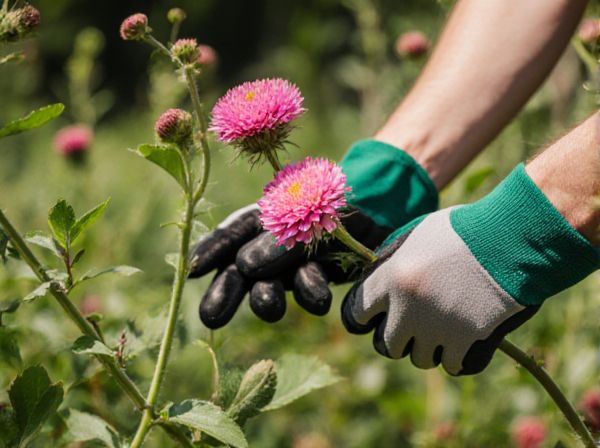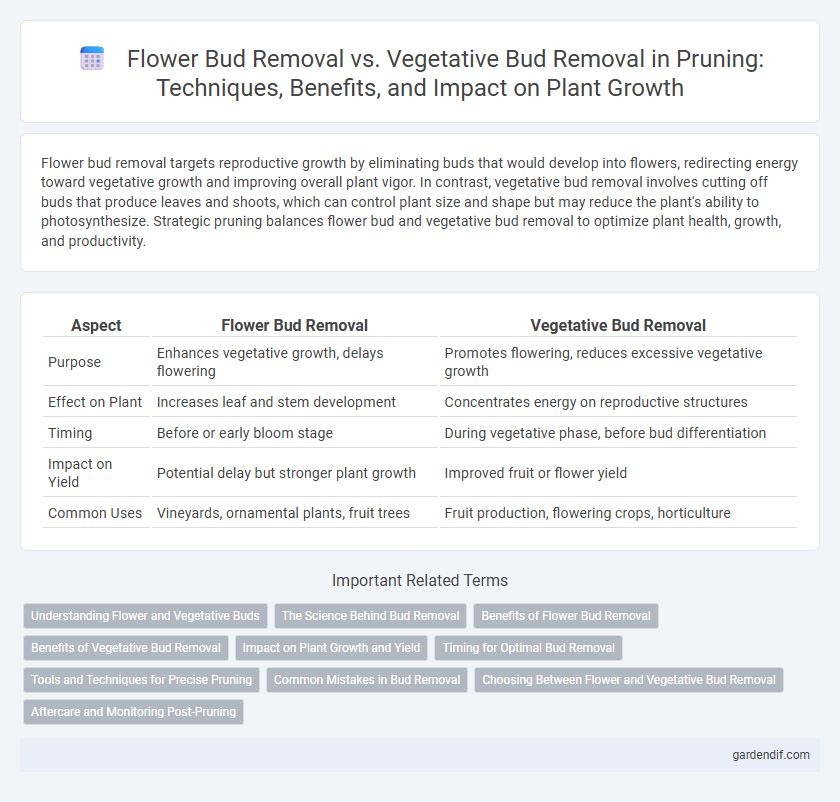
Flower bud removal vs vegetative bud removal Illustration
Flower bud removal targets reproductive growth by eliminating buds that would develop into flowers, redirecting energy toward vegetative growth and improving overall plant vigor. In contrast, vegetative bud removal involves cutting off buds that produce leaves and shoots, which can control plant size and shape but may reduce the plant's ability to photosynthesize. Strategic pruning balances flower bud and vegetative bud removal to optimize plant health, growth, and productivity.
Table of Comparison
| Aspect | Flower Bud Removal | Vegetative Bud Removal |
|---|---|---|
| Purpose | Enhances vegetative growth, delays flowering | Promotes flowering, reduces excessive vegetative growth |
| Effect on Plant | Increases leaf and stem development | Concentrates energy on reproductive structures |
| Timing | Before or early bloom stage | During vegetative phase, before bud differentiation |
| Impact on Yield | Potential delay but stronger plant growth | Improved fruit or flower yield |
| Common Uses | Vineyards, ornamental plants, fruit trees | Fruit production, flowering crops, horticulture |
Understanding Flower and Vegetative Buds
Flower buds contain reproductive structures that develop into blooms and are often plumper and rounder than vegetative buds, which primarily produce stems and leaves. Understanding the difference between flower bud removal and vegetative bud removal is crucial for managing plant growth and bloom timing effectively. Removing flower buds delays flowering and encourages vegetative growth, whereas removing vegetative buds can limit plant size and direct energy toward flowering.
The Science Behind Bud Removal
Flower bud removal redirects a plant's energy from reproduction to vegetative growth, enhancing leaf and shoot development for a robust structural framework. Vegetative bud removal influences hormone distribution, particularly auxins and cytokinins, modifying growth patterns and delaying flowering to extend the plant's productive lifespan. Scientific studies reveal that targeted bud removal manipulates resource allocation, improving overall plant vigor and optimizing yield potential.
Benefits of Flower Bud Removal
Flower bud removal enhances vegetative growth by redirecting the plant's energy toward the development of stronger stems and foliage. This practice improves overall plant health and fruit quality by preventing premature fruiting and allowing the plant to establish a more robust structure. Removing flower buds also increases future yield potential by promoting better flower and fruit set in subsequent growing seasons.
Benefits of Vegetative Bud Removal
Vegetative bud removal enhances plant vigor by directing energy toward stronger shoot development, resulting in improved canopy structure and increased photosynthetic capacity. This practice promotes better air circulation and light penetration, reducing disease risk and encouraging uniform fruit ripening. Removing vegetative buds also helps balance vegetative growth and fruit production, optimizing yield quality and size.
Impact on Plant Growth and Yield
Flower bud removal redirects the plant's energy from reproductive growth to vegetative growth, enhancing stem and leaf development but temporarily reducing fruit yield. Vegetative bud removal limits shoot growth and can promote flowering by stimulating dormant buds, potentially increasing fruit production in the following season. Understanding the balance between flower and vegetative bud removal is crucial for optimizing overall plant growth and maximizing long-term yield.
Timing for Optimal Bud Removal
Flower bud removal should be timed just before the buds begin to swell, typically in early spring, to maximize flowering potential and avoid energy loss in non-productive buds. Vegetative bud removal is most effective after the buds have fully developed and hardened, usually in late spring to early summer, promoting stronger shoot growth and improved plant structure. Precise timing tailored to the plant species ensures optimal nutrient allocation and overall plant health during the growing season.
Tools and Techniques for Precise Pruning
Flower bud removal requires delicate hand pruners or fine-tipped scissors to avoid damaging adjacent buds, emphasizing precision and care in technique. Vegetative bud removal often involves sharper, more robust tools like bypass pruners or pruning knives to efficiently cut tougher, woody stems. Mastery of angle cuts and targeted snips enhances growth direction and plant health by minimizing tissue damage and promoting optimal healing.
Common Mistakes in Bud Removal
Common mistakes in flower bud removal include cutting too early, which reduces the potential for bloom production, and removing buds indiscriminately, leading to uneven flowering and weakened plant structure. Vegetative bud removal errors often involve excessive pruning, causing stunted growth and delayed leaf development. Proper identification of bud type before removal is essential to avoid compromising the plant's growth cycle and overall health.
Choosing Between Flower and Vegetative Bud Removal
Flower bud removal targets reproductive structures to enhance vegetative growth, while vegetative bud removal reduces leaf and shoot development to concentrate energy on flower production. Choosing between flower and vegetative bud removal depends on crop goals, where prioritizing fruit yield favors flower bud elimination and promoting plant size prioritizes vegetative bud thinning. Understanding bud type location and plant developmental stage is crucial for optimizing pruning strategies and maximizing crop performance.
Aftercare and Monitoring Post-Pruning
After pruning, monitoring the plant's response to flower bud removal involves tracking new vegetative growth and ensuring adequate nutrition to support bud development. In contrast, vegetative bud removal requires close observation for potential reduced foliage density and increased susceptibility to pests, necessitating tailored fertilization and pest control measures. Timely aftercare, including watering and mulching, is essential to promote healthy regrowth and maintain overall plant vigor following both types of pruning.
Flower bud removal vs vegetative bud removal Infographic

 gardendif.com
gardendif.com